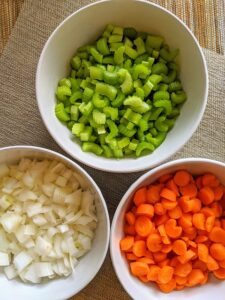The importance of knowing the how to freeze food to maintain its freshness cannot be overstated. Proper freezing techniques not only extend the shelf life of food but also preserve its taste, texture, and nutritional value. This article outlines the key steps involved in freezing food, from preparation to thawing and reheating, ensuring the freshness and safety of your meals.

Understanding the Basics
Freezing works by slowing down the enzyme activity that causes food to rot. When food is frozen, the water inside it turns to ice, making it difficult for bacteria to grow. However, the key to maintaining the quality of frozen food lies in managing the freezing temperature. The recommended temperature for freezing food is 0°F or below. A higher temperature can cause the food to enter the “danger zone” (between 40°F and 140°F), where bacteria multiply rapidly.
Preparation of Food for Freezing
Before freezing, it’s essential to clean and dry your food items. Washing fruits, vegetables, and meat removes any dirt, microbes, or pesticide residues while drying prevents the formation of ice crystals, which can affect the food’s texture and taste.
Cutting and trimming food into appropriate sizes and shapes before freezing not only makes it easier to pack but also speeds up the freezing process, which helps maintain the food’s quality. For instance, meat should be sliced into thin, flat shapes, while fruits and vegetables should be cut into bite-sized pieces.

Blanching, a process that involves briefly boiling vegetables before plunging them into ice water, is another crucial step in food preparation for freezing. This method deactivates the enzymes that cause vegetables to lose their color, flavor, and nutritional value, enabling them to retain their freshness after freezing.
How to Blanch Vegetables
- Fill a large pot or bowl with water and bring to a boil
- Put the vegetables in the boiling water for 2 minutes
- Immediately put the vegetables in ice water after removing from boiling water
- After cooling, drain and dry before freezing
Proper Freezing Techniques
Once you’ve prepared your food properly, the next step is to pack it tightly for freezing. When packing food, make sure to leave as little air as possible in the container or bag; otherwise, moisture will escape and cause freezer burn. To further help protect your food from freezer burn, wrap it in a layer of plastic wrap before placing it into a bag or container.
Once your food is packed and ready to freeze, make sure to place it in the freezer as quickly as possible so the food doesn’t thaw. Foods with higher water content will freeze faster, while those with less water take a bit longer.
Finally, make sure to check your freezer’s temperature often; at 0°F (or below), most foods will last indefinitely. This low temperature helps keep microbes from growing and keeps the food safe for consumption.
Label and Date Your Food
It’s essential to label and date your frozen food, so you know when it was prepared and how long it has been stored. You’ll also want to make sure to use the oldest items first; generally speaking, cooked foods can last up to two months in the freezer, while uncooked meals can last up to six. To help you remember when food was stored, make sure to write the date clearly on the container or bag.
With these freezing techniques and guidelines, you can safely store your frozen foods so they’ll retain their freshness and flavor for much longer. Enjoy!
Packaging and Storing Food for Freezing
Choosing the right containers for freezing food is as important as the preparation. Plastic bags, aluminum foil, and glass jars each have their pros and cons. Plastic bags are versatile and space-efficient; however, they may impart a plastic taste to the food if used for a long time. Aluminum foil is excellent for wrap-style packaging, but it can be prone to tears, leaks, and freezer burn. Glass jars, while environmentally friendly, risk cracking if overfilled.
To preserve the quality of the frozen food, it’s important to remove as much air as possible before sealing the package. Air can cause freezer burn, which results in dry, tasteless food. Vacuum sealers are a great option for this, but if unavailable, you can press out the air manually or use a straw to suck out the excess air.
Labeling your packages with the date and type of food will help you keep track of your inventory and ensure you consume the food while it’s still of good quality.
Say goodbye to Plastic
Preserve your food & protect your family with our organic, reusable food wraps

Proper Freezing Techniques
Different types of food require different freezing temperatures. For instance, meat and poultry should be frozen at 0°F, while fruits and vegetables can be frozen at slightly higher temperatures.
Avoid overloading your freezer. A too-full freezer can obstruct air circulation, leading to uneven freezing.
Fast freezing, a technique where the food is frozen rapidly, results in small ice crystals that help maintain the food’s cellular structure and thus, it’s texture and quality.
Thawing and Reheating
When it’s time to use your frozen food, proper thawing methods are key to maintaining their quality and safety. Thawing food in the refrigerator is the safest method, although it is the slowest. For quicker options, you can use cold water or a microwave.
Reheating tips vary based on the type of food, but a general rule is to reheat the food slowly to avoid overcooking. Below are a few examples of safe thawing methods.
How to Thaw a Roast Safely
Reheating a roast starts with thawing it, either in the refrigerator or using cold water. It’s best to allow 1-2 days of thawing for every 4-5 pounds of roast in the refrigerator. For faster methods, place the roast in a zip-top bag and submerge it in cold water until it is fully thawed.
Once the roast is thawed, it can be cooked in the oven or a slow cooker.
For optimal texture and flavor, bring roasts to room temperature before cooking them. This will help ensure that the roast cooks evenly throughout. This involves removing the roast from the refrigerator at least 30 minutes prior to cooking.
How to Thaw Fish Safely
When thawing fish, it’s important to keep it refrigerated until ready for use. Even if using cold water or a microwave, place the fish in a zip-top bag before submerging it or heating it.
Once thawed, fish should be cooked immediately. Never refreeze fish after it has been thawed, as this can lead to food poisoning.
To reheat the fish, preheat the oven to 350°F and place the thawed fish on a greased baking sheet. Cook for 10 minutes per inch of thickness or until an internal temperature of 145°F is reached.
It is also possible to reheat fish in the microwave. Place thawed fish on a microwave-safe dish, and then cover with plastic wrap or wax paper. Heat on high for 3 minutes per pound of fish or until it’s cooked through. Allow the fish to stand for 1 minute before serving.
How to Thaw a Turkey Safely
When it comes to thawing a turkey, the same rule applies—refrigerator or cold water. It’s best to allow 1 day of thawing for every 4-5 pounds of turkey in the refrigerator. If using cold water, submerge your Turkey in a zip-top bag and place it under running cold water until fully thawed.
Once your turkey is thawed, you can either cook it in the oven or a slow cooker. Make sure to preheat your oven to 325°F before cooking and use a thermometer to ensure that the internal temperature of any poultry reaches 165°F when finished.
Safe Reheating of Cooked Foods
When reheating cooked foods, be sure to bring it to a minimum internal temperature of 165°F. The best ways to do this are in the oven or on the stovetop. If using a microwave, cook food for several minutes and stir often to ensure even heating throughout.
It’s also important to remember that some frozen meals might need additional cooking time or ingredients such as water or broth. Be sure to follow package instructions for the best outcome.
When reheating food, it’s also important to remember that some foods don’t freeze well and are better enjoyed freshly cooked. When in doubt, throw it out! Reheated sauces may separate when frozen; soups can become grainy or separated; casseroles may become watery or mushy.
Finally, be sure to store and label all leftovers within 2 hours of cooking. Be sure to enjoy your frozen food within 4-6 months for optimal texture and flavor. With a few simple steps, you can save time while enjoying delicious meals!
Tips to Make Freezing Easier
When it comes to freezing food, there are a few tips to make it easier. First, be sure to freeze foods quickly so that the moisture doesn’t have time to escape. Secondly, it’s best to use airtight containers and bags when storing frozen items as this will help maintain quality and flavor. Finally, always label your packages with dates and contents before placing them in the freezer. That way, you will know what to expect when taking out items for a quick meal!
Follow these tips and you’ll be able to safely and easily store and enjoy frozen foods all year long. With the right storage techniques, your food can stay fresh for up to 4 months in the freezer and still taste delicious! Bon appetit!
Conclusion
As you can see, freezing food is an art and a science. From preparation to storage, every step can impact the quality of your frozen food. By adhering to these steps, you can preserve your food’s freshness, nutritional value, and taste, and have peace of mind knowing that you have a stockpile of healthy and tasty meals ready whenever you need them.
For more on safe short term food storage click here.
